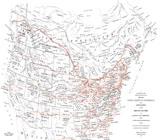Thomas Rawlings
Connecting the Railway through the United States
Rawlings felt that the great objects to be obtained by confederation should be commercial and this was best aided and abetted by an adequate railway system. In order to best develop the resources of the British North American provinces, and to provide a viable route to the Pacific and the markets of the Orient, he suggested using the proposed intercolonial route through Nova Scotia and New Brunswick, connecting up with the Grand Trunk line in Canada.
Concurring with Palliser’s assessment that the crossing of the Canadian shield north of the Great Lakes was totally impracticable, Rawlings reiterated the idea that his International Pacific Railway should dip into the United States using that country’s railway lines from Detroit, via the peninsula of Michigan, through Wisconsin and Minnesota to Pembina on the international border. From Pembina the railway would follow the Fertile Belt of the Hudson’s Bay territory, through the Leather (Yellowhead) Pass and terminate either at the head of Butte Inlet or some point in Dean Inlet.
As to how monies would be obtained to build the line, Rawlings merely states “the lands themselves will eventually pay for it.” However, for Rawlings it was the moral duty of England “to support them [the colonies] struggling through their days of experimental existence, and foster every attempt which they make to enlarge their sphere of action, extend civilization, commerce and assist them in developing their various elements of innate wealth.”
